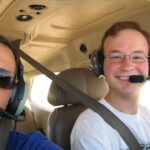Key Takeaways: Navigating Instrument Rating Certification Online
- Discover the roadmap to earning your Instrument Rating Certification through online courses.
- Learn about the core elements and features of top-tier IFR online training programs.
- Understand the comprehensive knowledge base required for a successful IFR pilot.
- Get insider tips on how to excel in the FAA Instrument Rating Test.
- Know what to look for when choosing the right online course to start your IFR training journey.
Your Pathway to Becoming an IFR Pilot
Embarking on the journey to become an Instrument Flight Rules (IFR) pilot is an exciting endeavor that opens up new skies and possibilities. It’s about more than just flying; it’s about mastering control and precision in less-than-perfect conditions. Online training courses are a flexible and comprehensive way to get started. They allow you to study at your own pace, fitting around your life commitments, and provide all the theoretical knowledge you need before you take to the skies.
Essential Course Features and Offerings
When you’re searching for the right online course, there are several key features to look out for. A great IFR training program should offer a mix of engaging multimedia content, interactive quizzes, and progress tracking. It should cover all the topics mandated by the FAA, from navigation and flight planning to understanding weather patterns and flight instruments. The best courses also provide support and resources to clarify doubts and ensure you’re on track for certification success.
The Scope of Knowledge for an IFR Pilot
IFR pilots need a solid foundation in various subjects to navigate the skies safely. This includes a deep understanding of en route charts, aircraft performance, and departure and arrival procedures. You also need to be well-versed in reading approach charts, executing holding patterns, and crafting a flawless IFR flight plan. Online courses are designed to cover these topics in detail, preparing you for both the exam and real-world flying.
How to Ace the FAA Instrument Rating Test
To ace the FAA Instrument Rating Test, it’s not just about memorizing facts; it’s about understanding concepts and applying them. The best online courses include practice tests that mimic the real exam, helping you to familiarize yourself with the format and types of questions you’ll encounter. They also provide explanations for each question, which reinforces learning and builds your confidence for test day.
Starting Your Journey with Instrument Rating Certification
Ready to start your journey towards becoming an IFR pilot? The first step is to gain your Instrument Rating Certification, which proves you have the skills to fly with limited visibility. This certification is crucial for any pilot who wants to fly in a broader range of conditions and is a stepping stone to advanced pilot credentials.
The Importance of Instrument Rating for Pilots
An Instrument Rating is essential for any pilot because it significantly increases safety and confidence. It allows you to fly in almost any weather condition and at all times of the day, which is not only practical but can be a lifesaver in unexpected situations. With this rating, you’re not just a fair-weather flyer; you’re a pilot equipped to handle the challenges of the sky.
What to Expect in an Online Instrument Rating Course
Online Instrument Rating courses are comprehensive programs designed to take you from a novice to a knowledgeable IFR pilot. You can expect a mix of video lectures, interactive modules, and plenty of resources to help you understand complex concepts. These courses are structured to make learning manageable and enjoyable, breaking down intricate topics into understandable segments. Plus, with the flexibility to learn at your own pace, you can ensure you fully grasp each subject before moving on to the next.
Choosing the Right Course: Factors to Consider
When it comes to choosing an online Instrument Rating course, there are several factors you should consider. The quality of the instructional material is paramount—look for courses with high-definition videos and clear, concise explanations. Check if the course updates its content regularly to comply with FAA regulations. Another important aspect is the availability of instructor support; being able to ask questions and get expert answers is invaluable. Lastly, consider the course’s success rate—how many of its students pass the Instrument Rating Test on their first try? This is a strong indicator of the program’s effectiveness.
Decoding Online Training: What’s in Store for You
Online training for your Instrument Rating is not just about watching videos and taking notes. It’s a dynamic and interactive experience designed to simulate as closely as possible the in-person training environment. With advanced simulators, interactive airspace maps, and real-time weather data, you’ll get a comprehensive understanding of what it takes to fly under IFR conditions. You’ll also have access to forums and discussion groups where you can connect with fellow students and share experiences and tips.
En Route Charts and Using Them Effectively
En route charts are the roadmaps of the sky for IFR pilots. They display critical information such as navigation aids, airspace boundaries, and altitudes. Effective use of these charts is crucial for safe navigation under instrument conditions. Your online course will teach you how to interpret the symbols and information on these charts, plan your route, and understand the air traffic control system that governs IFR flight.
Understanding Aircraft Performance Parameters
Every aircraft has its own set of performance parameters that are vital for IFR flight. This includes understanding stall speeds, service ceilings, fuel consumption, and weight and balance calculations. Your online training will delve into how these parameters affect your aircraft during different phases of flight and how to calculate and plan for these to ensure a safe flight under instrument conditions.
Mastering Departures & Arrival Procedures
IFR departures and arrivals are procedural dances that require precision and knowledge. Standard Instrument Departures (SIDs) and Standard Terminal Arrival Routes (STARs) are pre-defined routes that help manage traffic flow in and out of busy airspace. Your course will cover how to read and fly these procedures, ensuring you can transition smoothly from the en route phase of your flight to the approach and landing phases.
Deciphering Approach Charts for IFR Flights
Approach charts are the final pieces of the puzzle for IFR pilots. They provide detailed information on how to approach and land at an airport when visibility is low. These charts include information on minimum altitudes, approach procedures, and missed approach protocols. In your online course, you’ll learn to read these charts and understand the critical information they provide, so you can execute approaches with confidence.
Advanced Navigation and Flight Planning
Advanced navigation and flight planning go hand in hand for IFR pilots. It’s about more than plotting a course; it’s about anticipating changes, managing fuel, and understanding alternate routes. Your online training will give you the tools to create detailed flight plans that account for weather, airspace restrictions, and emergency procedures, ensuring you’re prepared for any scenario.
Navigating Using Advanced Avionics and Equipment
Modern avionics are a game-changer for IFR flight. From GPS to autopilot systems, the technology available to today’s pilots makes IFR navigation more precise and less stressful. Your online course will cover how to use this equipment effectively, ensuring you can leverage technology to maintain situational awareness and reduce workload during critical phases of flight.
Holding Patterns: The Art of Aerial Patience
Imagine you’re circling above your destination, waiting for clearance to land. This is where holding patterns come into play—a fundamental skill for IFR pilots. A holding pattern is a pre-determined route that keeps an aircraft within a specified airspace while awaiting further instructions. Online training courses teach you the ‘why’, ‘when’, and ‘how’ of entering and maintaining holding patterns, ensuring you’re ready to handle this common yet critical IFR procedure with calm and precision.
Crafting a Seamless IFR Flight Plan
A well-crafted IFR flight plan is your blueprint for a successful flight. It’s a detailed strategy that includes your route, expected weather, alternate airports, and emergency procedures. Creating a seamless plan requires a blend of knowledge and foresight. Online courses guide you through each step, from choosing routes that maximize efficiency and safety to filing your plan with the appropriate authorities. They ensure you leave nothing to chance, so you can focus on flying.
The Heart of IFR: Weather Theory and Flight Instruments
At the heart of IFR flying are two critical components: weather theory and flight instruments. Understanding the intricacies of weather patterns and how to interpret your instruments are skills that ensure safety and accuracy in the air. Online training courses provide in-depth lessons on both, using real-world scenarios to bring theory to life. They help you make informed decisions in the cockpit, no matter what the skies throw your way.
Weather Phenomena and IFR Implications
Weather can be unpredictable, and for IFR pilots, it’s a constant consideration. From understanding how different weather systems affect flight conditions to knowing the implications of ice, turbulence, and thunderstorms, online courses cover it all. They teach you to read weather reports and forecasts, interpret radar images, and plan accordingly. With this knowledge, you can anticipate and mitigate weather-related risks, ensuring a safer IFR flight experience.
The Role and Reading of Flight Instruments
Flight instruments are the eyes of an IFR pilot in conditions where visibility is compromised. Your online training will show you how to read and interpret these instruments accurately. You’ll learn about the six-pack—the primary flight instruments—and how they work together to give you a clear picture of your aircraft’s attitude, altitude, speed, and directional heading. Mastery of these instruments is non-negotiable for safe and efficient IFR flight.
Regulatory Know-How: FAA Regulations and AIM
Every IFR pilot must navigate not just the skies but also the regulations that govern them. The Federal Aviation Regulations (FARs) and the Aeronautical Information Manual (AIM) are the rulebooks of the sky. Online training courses ensure you’re not just familiar with these regulations, but that you understand how to apply them in practice. This knowledge is not only crucial for passing your Instrument Rating Test but also for your conduct as a responsible aviator.
Navigating Federal Aviation Regulations (FARs)
Federal Aviation Regulations are the laws of aviation, and as an IFR pilot, you need to know them inside and out. Online courses break down the FARs into digestible sections, focusing on those most pertinent to instrument flight. They teach you how to stay compliant with airspace rules, the requirements for IFR flight plans, and the legalities surrounding instrument procedures. This ensures you’re not just a skilled pilot but also a lawful one.
Applying Aeronautical Information Manual (AIM) Knowledge
The Aeronautical Information Manual is your encyclopedia of aviation knowledge. It covers everything from airport operations to emergency procedures. In your online training, you’ll learn how to use the AIM as a reference to supplement your flying skills. This includes understanding air traffic control procedures, communication protocols, and navigation techniques. Applying AIM knowledge effectively is a mark of an experienced and proficient IFR pilot.
Earning Your Wings: Preparing for the IFR Written Test
Getting ready for the IFR written test is a significant milestone on your path to becoming a certified instrument-rated pilot. This exam is where you’ll need to show your understanding of everything from flight theory to practical navigation skills. It’s not just about passing; it’s about laying the groundwork for safe and proficient flying when visibility is low. The key is to prepare methodically and thoroughly, ensuring that you’re not just memorizing information, but truly comprehending and able to apply it.
The Approach to Acing Your IFR Written Test
To ace your IFR written test, a strategic approach is crucial. Start by creating a study schedule that covers all the topics you’ll be tested on. Break down the material into manageable sections and set realistic goals for each study session. It’s not just about quantity; quality matters too. Focus on understanding the ‘why’ behind each concept, which will help you retain the information and apply it during the test—and in the cockpit.
Practice Makes Perfect: Using Test Prep Effectively
Practice is the bridge between studying and passing your IFR written test. Online test prep tools can be incredibly beneficial. They provide a bank of practice questions that simulate the actual exam, allowing you to become familiar with the format and types of questions you’ll encounter. By taking regular practice tests, you’ll identify areas where you need further study and get comfortable with the testing process. Remember, every practice question you answer is another step towards your goal.
Learning from the Best: The Kings’ Approach to IFR Training
When it comes to IFR training, John and Martha King are legendary. With decades of experience in pilot education, their courses are revered for their effectiveness and engaging teaching style. They’ve helped countless pilots achieve their Instrument Rating, and their approach is one that combines expertise with a genuine passion for flying. Learning from the Kings means getting insights from two of the most experienced and respected figures in the field.
Experience with John and Martha King’s Teaching Techniques
The King’s teaching techniques are renowned for being clear, memorable, and practical. They use real-world scenarios to illustrate complex concepts, making it easier for you to grasp and remember. Their videos often feature both John and Martha, providing different perspectives and teaching styles that cater to a wide range of learning preferences. By incorporating humor and relatable examples, they turn challenging subjects into enjoyable learning experiences.
Using Their Methods to Enhance Your Understanding
Adopting the King’s methods in your own study routine can significantly enhance your understanding of IFR concepts. Their focus on clear explanations helps demystify complicated topics, while their practical tips can be directly applied to your flying practice. By following their structured approach to learning, you’ll build a strong foundation of knowledge that will serve you well, both during the written test and in real-life flying situations.
The Guarantee: You Will Pass Your IFR Written Test
One of the most reassuring aspects of the King’s courses is their guarantee: follow their program, and you will pass your IFR written test. This bold promise is backed by their comprehensive course material, their effective teaching methods, and their commitment to student success. It’s a testament to the confidence they have in their program and its ability to prepare you for the test and for safe, competent flying.
How KING Courses Ensure Your Success
KING courses are designed with one goal in mind: your success. They ensure this by providing you with a complete and always-current syllabus that covers all the necessary subject areas. The course is structured to reinforce learning through FAA-style test questions that follow each segment. With the ability to take unlimited practice tests, you’ll gain the knowledge, skills, and confidence needed to pass your IFR written test. And with their guarantee, you have an extra layer of assurance that you’re on the right path.
What to Do If You’re Struggling with Course Material
If you find yourself hitting a wall with your IFR course material, don’t worry—that’s a common challenge, and there are several strategies to help you overcome it. First, take a break and give yourself some time to process the information. Next, reach out for help; whether it’s connecting with instructors, joining study groups, or seeking online forums, there’s a community ready to support you. Additionally, try different learning methods, such as interactive simulations or drawing out concepts. Remember, persistence is key, and every pilot has been where you are now.
FAQ: Instrument Rating Certification Online
How Long Does It Take to Complete an Online Instrument Rating Course?
- Varies based on individual pace and commitment
- Typically ranges from 2-3 months with consistent study
- Accelerated courses can be completed in a shorter timeframe
- Access to the course material is often available for an extended period for review
Can I Use Online Courses for Actual IFR Flight Training?
Online courses are primarily designed to provide the theoretical knowledge required for IFR flight training. While they don’t replace actual flight hours, they are an invaluable resource for understanding the principles and procedures of instrument flying. You’ll still need to log flight hours with a certified instructor to gain practical experience and meet the FAA’s requirements for the Instrument Rating.
What’s the Difference Between Online Courses and In-Person Training?
- Online courses offer flexibility and convenience, allowing you to learn at your own pace and schedule.
- In-person training provides hands-on experience and direct interaction with instructors and aircraft.
- Both are essential components of a comprehensive IFR training program.
How Much Does an Online Instrument Rating Course Typically Cost?
The cost of online Instrument Rating courses can vary widely based on the provider and course features. On average, you can expect to spend anywhere from $200 to $500 for a quality course. This is often a cost-effective option compared to in-person ground school, not factoring in the savings on commuting and materials.
What Are the Technical Requirements for Online Instrument Rating Training?
To ensure a smooth learning experience, you’ll need a stable internet connection, a computer or tablet capable of streaming video content, and possibly a headset for interactive elements. Most courses are designed to be accessible on various devices, so you can study whether you’re at home or on the go.
As we wrap up, remember that earning your Instrument Rating is a significant milestone on your journey to becoming a pilot. It’s a challenging yet rewarding process that equips you with the skills to fly confidently in a range of conditions, broadening your horizons both literally and figuratively.
So, take that first step, choose the course that’s right for you, and commit to your training. The skies await, and with the right preparation, you’ll be ready to join the ranks of skilled IFR pilots. Clear skies and tailwinds to you on your aviation journey!







Leave a Reply